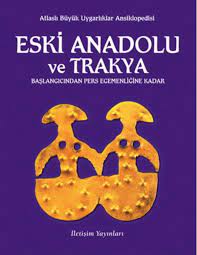by Doğan Hızlan
The increasing interest in archeology in recent years proves that we learn especially about Thrace and Anatolia better, and that the source of many cultures and arts comes from these lands.
* * *
Sevin ‘s work; It covers a period of time from the beginning of these lands (Paleolithic) to their entry into Persian rule. This work includes the Paleolithic Age, Neolithic Age, Chalcolithic Age, Early Bronze Age and Iron Age .
In addition to the text, 66 maps, 600 pictures, 262 drawings and 10 tables strengthen the visuality.
Archaeologist Sevin states in the Foreword how we rediscovered our own culture with the help of archeology:
‘But until yesterday, we could not fully understand this creator in him, we always saw Greece, Rome, Mesopotamia, Egypt, Syria or Crete as the homeland of original cultures and great inventions.
Archaeological discoveries made in the last thirty years have gradually begun to change and correct these preconceived views. It was determined that the transition from caves to the first permanent shelters and villages arose in these lands. It was determined that animals and plants were domesticated here for the first time. It was revealed that the foundations of trade began to be laid here, and the first great cities, temples and stone sculptures were formed here.’
* * *
While reading Ancient Anatolia and Thrace , you will realize how this region, this peninsula, was the land of the firsts in the history of civilization.
Indeed, when one learns these, one acquires the necessary information and gains a perspective in order to view Anatolia from a cultural rather than an ideological point of view, as the researcher said.
* * *
I have come to the conclusion that such a book is a unique resource in determining the place of the country in which he lives in the world, in archeology and in the development of humanity.
Once upon a time, archeology was regarded as the work of archaeologists, and it was not thought of how the excavations changed and enriched the information on the ground.
However, we all know today that it is possible to learn about the past and the present with its cultural identity, especially when it comes to Anatolian lands, through archaeological studies.
Archeology in TurkeyI was happy in two ways: Sevin included the names of those who gave their lives to the establishment, recognition, prestige and interest of archeology in Turkey with their efforts in this branch.
Who ?
Osman Hamdi Bey, Arif Müfid Mansel, Ekrem Akurgal, H. Zübeyir Kosay, U. Bahadır Alkım, Tahsin Özgüç, Halet Çambel, Jale İnan, Nimet Özgüç, Ufuk Esin.
* * *
Wandering through the pages of Ancient Anatolia and Thrace , you will make an informed and entertaining trip.
You come across Tilkitepe , a commercial station on the shores of Lake Van , wander along the Euphrates, into a merchant town, Değirmentepe.Do not neglect Arslantepe , which is described as a palace city in Malatya .
In the pages of Troy Treasures , experience the sadness of losing a fortune that is ours, However, do not forget the pride that Troia is also in these lands.
From Veli Sevin ‘s study of the Hittite Empire , you can once again understand the importance of this empire in a language that everyone can understand.
The Development of Writing – Hittite Language and Writing section informs us about the history of the writing civilization:
‘The Hittites, who called themselves Neşali, used two types of writing, cuneiform and pictorial (hieroglyphic), and called the language they spoke Neşa’ca (neşiumnili).
The number of clay tablets found in the state archives in Boğazköy exceeds 25,000.
Famous Women of Anatolia . The ones in the book show that the beauty symbol women that we portray in our imagination do not match the reality.
Midas see your face ‘ta, King Midas ‘ tomb and how I found the etlendiril can read the story of the skull found.
I think your curiosity will make you ask this question.
Midas’Is the Legend of Donkey Ears true?
It’s true. Midas had long hair on his ears and looked even bigger than usual.
* * * When you finish reading, I have no doubt that you will not be able to avoid some associations about today.
Veli Sevin ‘s Old Anatolia and Thrace book tells us the importance of Anatolian civilization in a plain, understandable language that is not drowned in terms.
Even if you are not interested, this book will make you love archeology.
He will also fall in love with Anatolia.
Veli Sevin was born in Ödemiş in 1944, studied at the Faculty of Letters at Istanbul University.
Head of Archeology Department at Van Yüzüncü Yıl University
https://www.hurriyet.com.tr/arkeoloji-icin-bulunmaz-yol-haritasi-153133





















